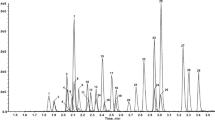Abstract
Hair samples taken from 850 individuals with presumed drug abuse were tested simultaneously forΔ9tetrahydrocannabinol (THC), cocaine, heroin, the primary heroin metabolite 6-monoacetylmorphine (6-MAM) and morphine. The drugs were extracted with methanol under sonication. Compared to other extraction procedures this solvent extraction technique provides high extraction yields and less experimental effort. The analyses were carried out using gas chromatography - mass spectrometry (GCMS) in selected ion monitoring (SIM) mode. This procedure allows the simultaneous detection of amphetamine, methylenedioxyamphetamine (MDA), methylenedioxymetbamphetamine (MDMA) and methylenedioxyethylamphetamine (MDE). THC was found in 104 (12.2%), cocaine in 230 (27%) and 6-MAM in 141 (16.6%) samples. In addition to 6-MAM, morphine was detected in 87 (10.2%) and heroin in 38 samples (4.5%). The concentrations found were in a range 0.009-16.7 ng/mg for THC, 0.037-129.68 ng/mg for cocaine, 0.028-79.82 ng/mg for 6-MAM, 0.045-53.14 ng/mg for heroin and 0.011-7.800 ng/mg for morphine. The statistical distribution of the drug concentrations compared with the self-reported consumption behaviour of the users may possibly lead to a better understanding of the relationship between drug dosage and corresponding concentrations in hair.
Similar content being viewed by others
References
Cone EJ (1990) Testing human hair for drugs of abuse. 1. Individual dose and time profiles of morphine and codeine in plasma, saliva, urine and beard, compared to drug induced effects of pupils and behaviour. J Anal Toxicol 14:1–7
Möller MR, Fey P, Wennig P (1993) Simultaneous determination of drugs of abuse (opiates, cocaine and amphetamine) in human hair by GC/MS and its application to a methadone treatment program. Forensic Sci Int 63:185–206
Derks HJGM, Van Twillert K, Zomer G (1985) Determination of 6-monoacetylmorphine in urine as specific marker for heroin abuse by high performance liquid chromatography with fluorescence detection. Anal Chim Acta 170:13–20
Goldberger BA, Caplan YH, Maguire T, Cone EJ (1991) Testing human hair for drugs of abuse: III. Identification of heroin and 6-acetylmorphine as indicators of heroin use. J Anal Toxicol 15:226–231
Cone EJ, Darwin WD, Wang WL (1993) The occurrence of cocaine, heroin and metabolites in hair of drug abusers. Forensic Sci Int 63:55–68
Tagliaro F, Traldi P, Pelli B, Maschio S, Neri C, Margio M (1987) Determination of morphine and other opioids in the hair of heroin addicts by RIA, HPLC and collisional spectroscopy. In: Piermonte B (ed) Dev Anal Methods Pharm Biomed Forensic Sci Plenum, New York, pp 115-127
Rothe M, Pragst F (1995) Solvent optimization for the direct extraction of opiates from hair samples. J Anal Toxicol 19: 236–240
Nakahara Y, Takahashi K, Shimamine M, Takeda Y (1991) Hair analysis for drug abuse: 1. Determination of methamphetamine and amphetamine in hair by stable isotope dilution gas chromatography/mass spectrometry method. J Forensic Sci 36:70–78
Sachs H, Raff I (1993) Comparison of quantitative results of drugs in human hair by GC/MS. Forensic Sci Int 63: 207–216
Cone EJ, Yousefnejad D, Darwin WD, Maguire T (1991) Testing human hair for drugs of abuse: II. Identification of unique cocaine metabolites in hair of drug abusers and evaluation of decontamination procedures. J Anal Toxiol 15: 250–255
Henderson L, Herkey MR, Zhou C, Jones RT (1992) Cocaine and metabolite concentrations in the hair of South American coca chewers. J Anal Toxicol 16:190–210
Möller MR, Fey P, Rimbach S (1992) Identification and quantitation of cocaine and its metabolites, bezoylecgonin and ecgonin methyl ester, in hair of Bolivian coca chewers by gas chromatography/mass spectrometry. J Anal Toxicol 16: 291–296
Nakahara Y, Kitura R (1994) Hair analysis for drugs of abuse: VII. The incorporation rates of cocaine, bezoylecgonin and ecgonin methyl ester into rat hair and hydrolysis of cocaine in rat hair. Arch Toxicol 68:54–59
Möller MR, Fey P, Sachs H (1993) Hair analysis as evidence in forensic cases. Forensic Sci Int 63:43–53
Author information
Authors and Affiliations
Rights and permissions
About this article
Cite this article
Kauert, G., Röhrich, J. Concentrations of Δ9-tetrahydrocannabinol, cocaine and 6-monoacetylmorphine in hair of drug abusers. Int J Leg Med 108, 294–299 (1996). https://doi.org/10.1007/BF02432123
Received:
Accepted:
Issue Date:
DOI: https://doi.org/10.1007/BF02432123




